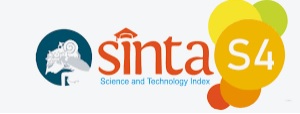Analisis Perilaku Pengguna Dalam Penerapan LMS Moodle Mobile Menggunakan Metode TAM
Abstract
Muhammadiyah Sidoarjo University is one of the universities that implements an e-learning learning model using an LMS called Moodle UMSIDA. However, the adoption of these applications is not without drawbacks such as failed logins and other feature failures. This problem causes students to prefer using other e-learning alternatives so that the UMSIDA Moodle application becomes less desirable. The purpose of this study was to analyze the factors that influence the acceptance of the UMSIDA Moodle application. The study used the TAM model which was adopted and modified based on the model developed by Said a Salloum. There were 385 response data from students obtained through distributing questionnaires online which were then analyzed using SEM-PLS. Based on the results obtained in this study, the variables perceived ease of use, perceived usefulness, accessibility, computer self-efficacy and behavioral intention are significant for the acceptance of the UMSIDA Moodle application.
Keywords: E-learning; Modified Technology Acceptance Model; Structural Equation Modeling; Partial Least Squares; SmartPLS
Â
Abstrak
Universitas Muhammadiyah Sidoarjo adalah salah satu universitas yang menerapkan model pembelajaran e-learning menggunakan LMS bernama Moodle UMSIDA. Namun, adopsi aplikasi tersebut tidak luput dari kekurangan seperti gagal saat melalukan login dan kegagalan fitur lainnya. Masalah tersebut menyebabkan mahasiswa lebih memilih menggunakan alternatif e-learning lain sehingga aplikasi Moodle UMSIDA menjadi kurang diminati. Tujuan penelitian ini adalah melakukan analisis terhadap faktor-faktor yang mempengaruhi penerimaan aplikasi Moodle UMSIDA. Penelitian menggunakan model TAM yang diadopsi dan dimodifikasi berdasarkan model yang dikembangkan oleh Said a Salloum. Terdapat 385 data tanggapan dari mahasiswa yang diperoleh melalui penyebaran kuesioner secara daring yang kemudian dianalisis menggunakan SEM-PLS. Berdasarkan hasil yang diperoleh pada penelitian ini bahwa variabel perceived ease of use, perceived usefulness, accessibility, computer self-efficacy dan behavioural intention signifikan terhadap penerimaan aplikasi Moodle UMSIDA.
Keywords
References
Kidi, “Teknologi Dan Aktivitas Dalam Kehidupan Manusia,†J. Pendidik., vol. 28, pp. 1–28, 2018.
K. A. N. Imania and S. K. Bariah, “Rancangan Pengembangan Instrumen Penilaian Pembelajaran Berbasis Daring,†J. PETIK, vol. 5, pp. 31–47, 2019.
E.N. Wicaksana, A. Faroqi, & A. Wulansari, "Analisis Penerimaan Mahasiswa Indonesia Terhadap Teknologi Digital Layanan Distribusi Konten Audio Melalui Podcast". Jutisi: Jurnal Ilmiah Teknik Informatika dan Sistem Informasi, vol. 11, no. 2, pp. 325-334, 2022.
M. E. Yalcin and B. Kutlu, “Examination of students’ acceptance of and intention to use learning management systems using extended TAM,†vol. 50, no. 5, pp. 2414–2432, 2019, doi: 10.1111/bjet.12798.
S. K. Munabi, J. Aguti, and H. M. Nabushawo, “Using the TAM Model to Predict Undergraduate Distance Learners Behavioural Intention to Use the Makerere University Learning Management System,†OALib, vol. 07, no. 09, pp. 1–12, 2020, doi: 10.4236/oalib.1106699.
J. P. Ningtyas et al., “Analisis Faktor Penerimaan Google Classroom Menggunakan Technology Acceptance Model DI,†vol. 2, no. 2, pp. 265–274, 2021.
S. A. Salloum, A. Qasim, M. Alhamad, M. Al-emran, A. Abdel, and K. Shaalan, “Exploring Students ’ Acceptance of E-learning through the Development of a Comprehensive Technology Acceptance Model,†IEEE Access, vol. PP, p. 1, 2017, doi: 10.1109/ACCESS.2019.2939467.
B. Sudaryana, Metode Penelitian : Teori dan Praktek Kuantitatif dan Kualitatif, Cetakan Pe. Yogyakarta: Deepublish, 2018.
D. Handayani, “Corona Virus Disease 2019,†J. Respirologi Indones., vol. 40, no. April 2020, pp. 119–129, 2020, doi: 10.36497/jri.v40i2.101.
Sugiyono, Metode Penelitian Kuantitatif, Cet. 1. Bandung: Alfabeta, 2018.
R. A. S. Al-Maroof and M. Al-Emran, “Students Acceptance of Google Classroom : An Exploratory Study using PLS-SEM Approach,†vol. 13, no. 6, pp. 112–123, 2018, doi: https://doi.org/10.3991/ijet.v13i06.8275.
G. Priambodo, T. Theresiawati, and R. Wirawan, “ANALISIS PENERIMAAN DAN PENGGUNAAN APLIKASI SiKerja : Di Lingkungan Kementerian Dalam Negeri Menggunakan Pendekatan Technology Acceptance Model (TAM),†J. Ilmu Tek. dan Komput., vol. 6, no. 1, p. 86, 2022, doi: 10.22441/jitkom.v6i1.010.
Sugiyono, Metode Penelitian Kuantitatif, Kualitatif Dan R&D. Bandung: Alfabeta, 2016.
Solimun, A. A. R. Fernandes, and Nurjannah, Metode Statistika Multivariat : Pemodelan Persamaan Struktural (SEM) Pendekatan WarpPLS, Cetakan Ke. Malang: Universitas Brawijaya Press, 2017.
R. Ramadiani, U. Mulawarman, A. Azainil, U. Mulawarman, and A. N. Hidayanto, Model dan Bentuk Penelitian E-Learning Menggunakan Structural Equation Model, Cetakan Pe., no. February. Samarinda: Mulawarman University Press, 2019.
E. C. Awalukita, Kusnandar, and Setyowati, “Pengaruh Experiential Marketing Terhadap Kepuasan Dan Loyalitas Pelanggan Restoran Pempek Ny. Kamto Di Surakarta,†Agrista, vol. 8, no. 4, pp. 27–38, 2020.
How To Cite This :
Refbacks
- There are currently no refbacks.











